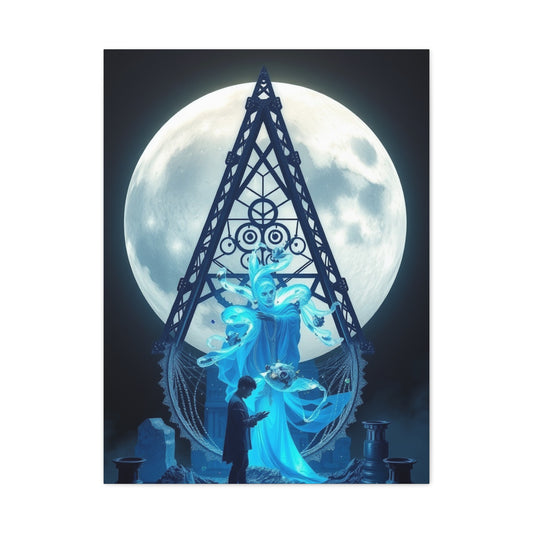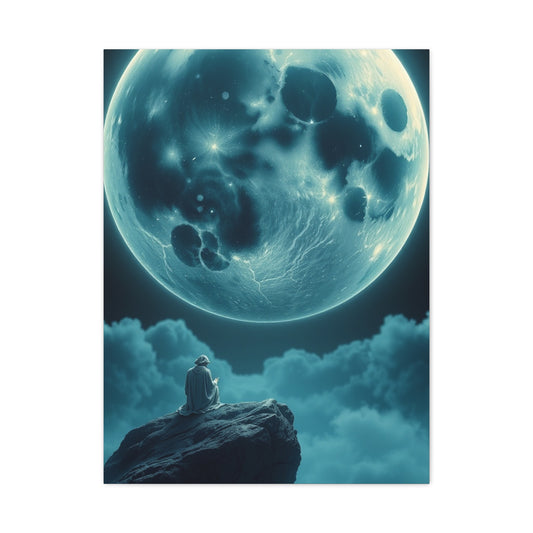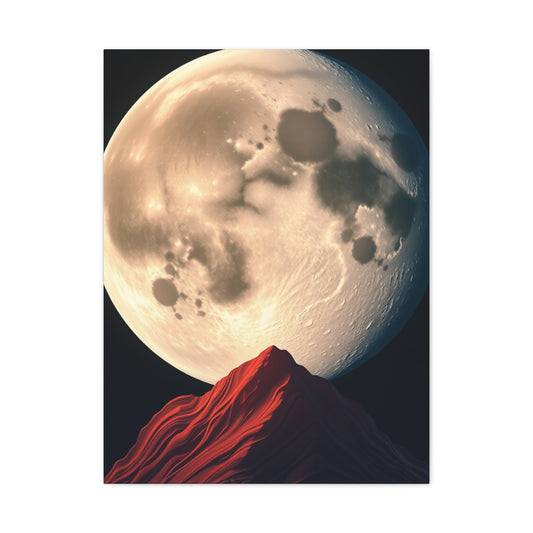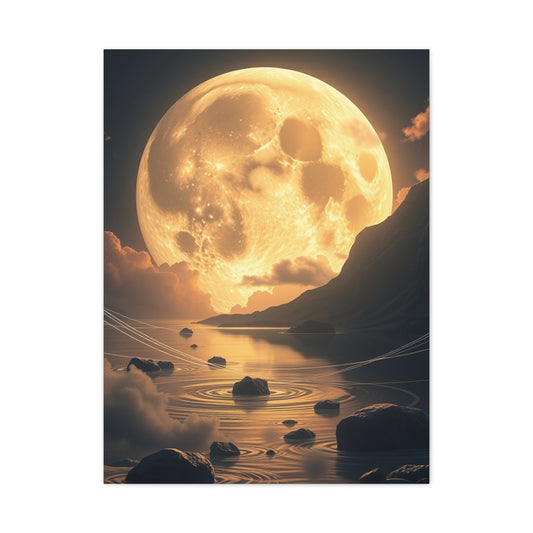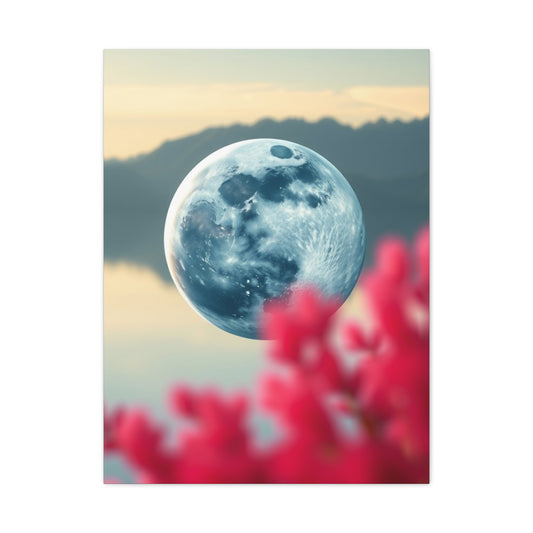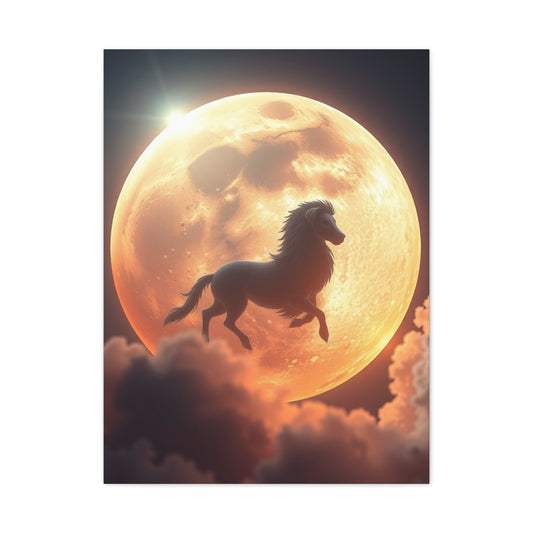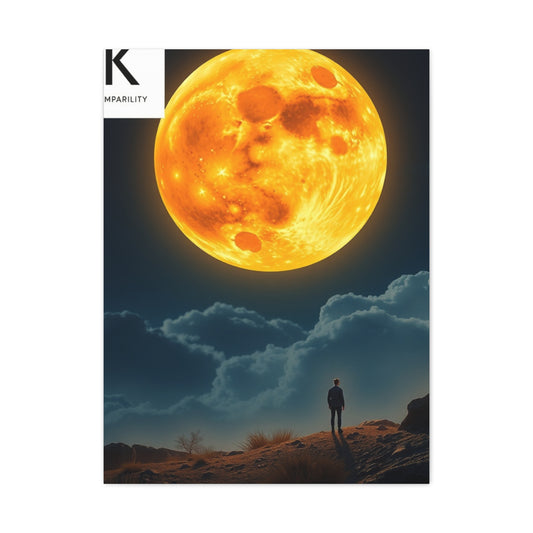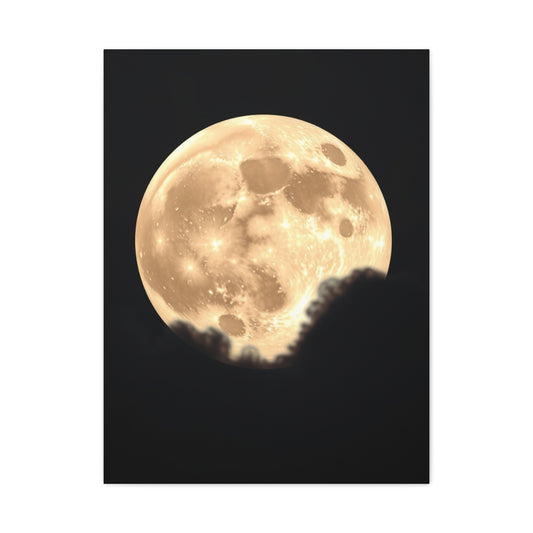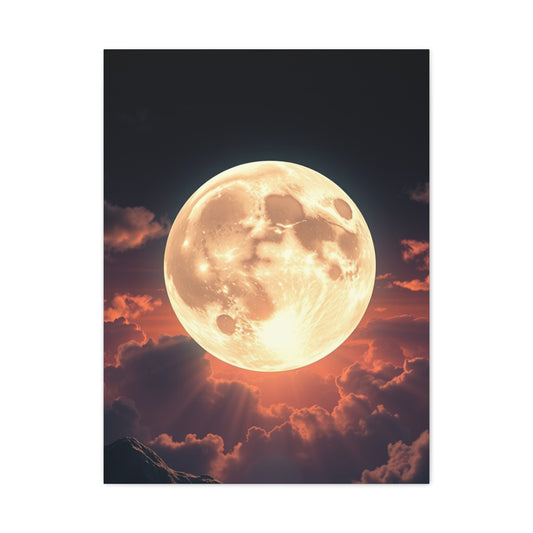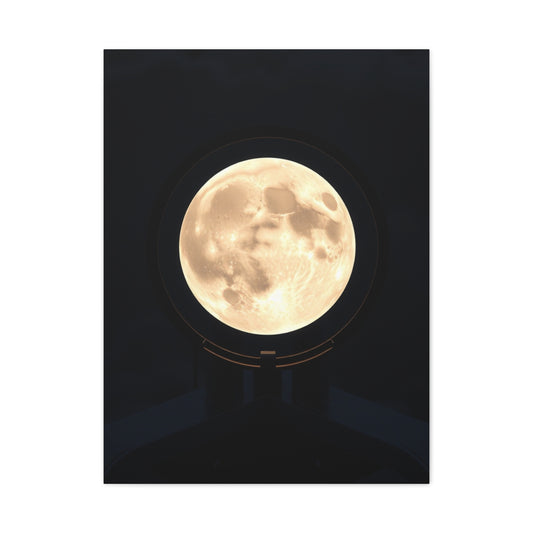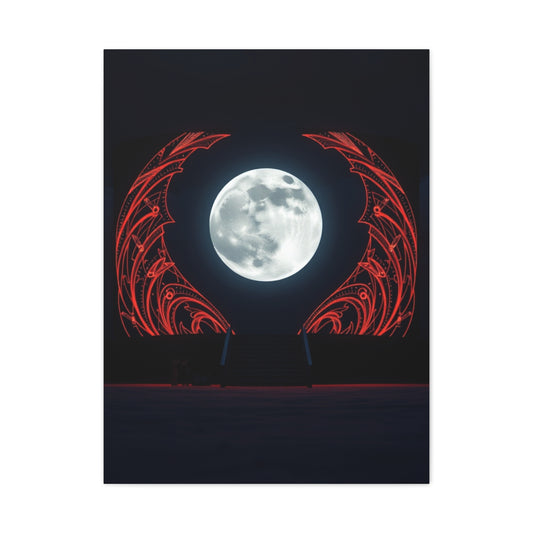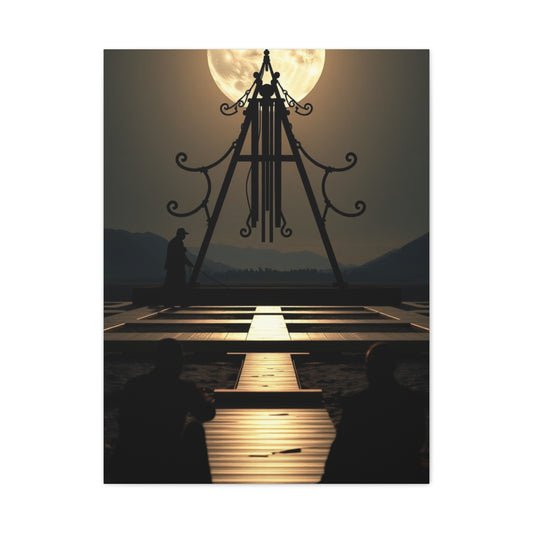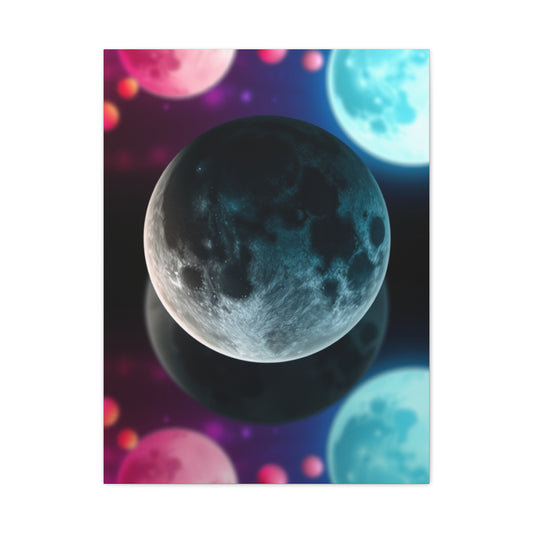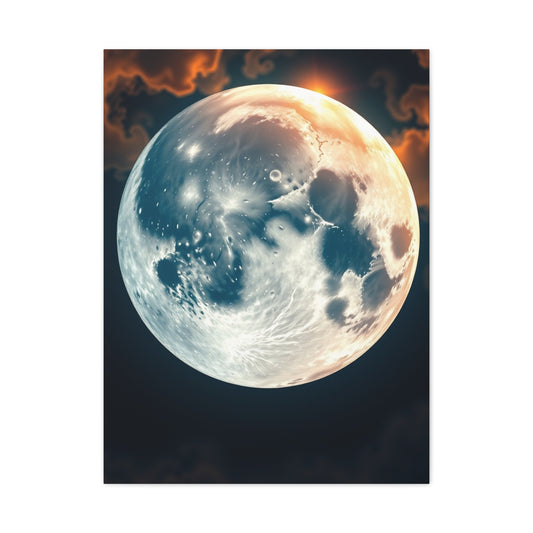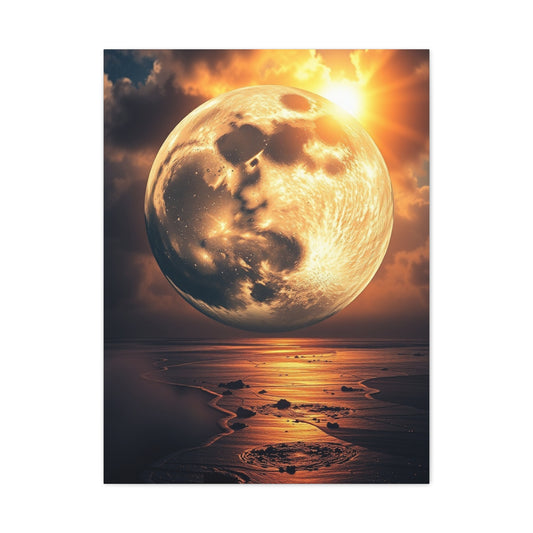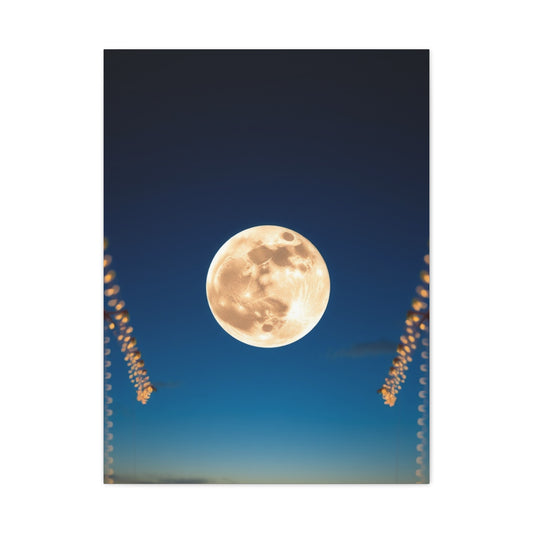Beautiful Celestial Moon Wall Art Décor
Since the dawn of time, humanity has gazed upon the moon with reverence and awe. This celestial body, with its serene glow, has inspired myths, shaped rituals, and influenced cultures across the globe. From ancient temples to modern homes, its symbolism has transcended mere astronomy, weaving itself into the very heart of human expression. One of the most enchanting ways this fascination has manifested is through artistic representation. Among these, moon wall art has emerged as a profound medium that unites aesthetics, spirituality, and design. It not only beautifies interior spaces but also acts as a bridge between earthly living and cosmic wonder.
The appeal of the moon lies not only in its luminous presence in the night sky but also in its metaphorical power. It embodies renewal, balance, and a rhythm that mirrors the cycles of human life. The allure of moon-inspired art is therefore timeless, touching on both personal sentiment and universal symbolism. In today’s world, moon wall art has become more than mere decoration; it is a way of anchoring mystical energy and poetic beauty into everyday spaces.
Historical Background
The fascination with the moon predates recorded history. Archaeological evidence reveals lunar markings carved into bones and stones dating back to prehistoric times. These primitive inscriptions show how early humans tracked the waxing and waning of the moon, aligning their lives with its cycles. As civilizations blossomed, the moon assumed more elaborate roles in religious practices, artistic expressions, and cultural narratives.
In ancient Egypt, the moon was revered as a deity embodying time and rebirth. Wall carvings in tombs often depicted lunar phases, symbolizing eternal cycles. In Mesopotamian culture, the moon god Sin was associated with wisdom and the measurement of time, and temples dedicated to him were adorned with lunar emblems. Similarly, in Greece, Selene and Artemis embodied feminine power and lunar grace, often represented in sculptures and frescoes that later inspired Renaissance painters.
Eastern traditions also embraced the moon’s beauty. In Chinese art, the moon became a symbol of reunion and harmony, often depicted in ink paintings of landscapes where moonlight illuminated rivers, mountains, and pavilions. Japanese ukiyo-e prints captured delicate moments of moonlit nights, emphasizing tranquility and introspection. These visual traditions influenced global aesthetics, laying the foundation for moon wall art as we know it today.
By the time of the Romantic era in Europe, painters such as Caspar David Friedrich immortalized moonlit landscapes, evoking emotions of solitude, longing, and spirituality. Such works resonated with the growing human desire to connect with nature and the cosmos. This lineage continues in contemporary homes, where moon wall art is celebrated for both its decorative elegance and symbolic depth.
Core Concepts and Foundations
At the heart of lunar imagery lies a set of profound concepts that give moon wall art its enduring appeal.
The moon represents cycles of growth, transformation, and renewal. Its phases echo human experiences of expansion, introspection, decline, and rebirth. A waxing crescent mirrors new beginnings and hope, the full moon symbolizes abundance and clarity, while the waning phases embody release and reflection. These cycles have been universally recognized, making moon motifs powerful archetypes that resonate across cultures.
The moon also embodies femininity. Its soft radiance, cyclical rhythm, and nurturing symbolism have made it a figure of womanhood, fertility, and intuition. Many ancient cultures regarded lunar goddesses as protectors, healers, and guides. When incorporated into wall art, this symbolism infuses interiors with a sense of grace, balance, and gentle strength.
Equilibrium is another foundational theme. The interplay between the sun and moon creates a duality—day and night, activity and rest, light and darkness. The moon balances the intensity of the sun, offering calmness, subtlety, and serenity. This balance is often mirrored in artworks where the moon is paired with other celestial symbols, creating harmony within the composition and, in turn, within the space it inhabits.
Moon wall art thus becomes more than visual embellishment. It is a manifestation of timeless concepts—cycles, femininity, and balance—that carry both personal meaning and universal resonance.
Types and Categories
Moon wall art encompasses a vast spectrum of styles, materials, and artistic interpretations, reflecting the diverse ways people have envisioned the moon across centuries.
One of the most popular forms is the depiction of moon phases. Artists arrange crescents, half-moons, and full moons in linear or circular sequences, often crafted from metal, wood, or painted on canvas. These phase-oriented pieces serve as reminders of life’s constant rhythm and change.
Another category is moonlit landscapes, where the glowing orb illuminates oceans, forests, mountains, or city skylines. These works combine natural and cosmic beauty, transforming walls into portals of serenity. They evoke the mystery of nighttime, inviting viewers into contemplative states.
Abstract renditions are equally captivating. Some artworks portray the moon as textured circles with craters and gradients, while others experiment with geometric patterns and surrealist interpretations. These contemporary styles appeal to modern sensibilities, blending lunar mystique with bold artistic innovation.
Functional categories also exist. Moon wall clocks, for example, merge utility with symbolism. Each glance at the clock becomes a subtle reminder of eternity and cyclical flow. Similarly, moon mirrors and tapestries serve both aesthetic and practical purposes, adding depth, reflection, or softness to a room.
For those who appreciate tactile artistry, moon wall art crafted in metal, glass, or ceramic offers dimensionality. These pieces add texture, shadow, and presence, transforming flat walls into dynamic surfaces. Large-scale murals, whether hand-painted or digitally printed, bring dramatic impact, enveloping entire rooms in lunar splendor.
Practical Applications
Incorporating moon wall art into interiors requires thoughtfulness to align aesthetic intention with symbolic depth.
Scale plays a crucial role. A large full-moon mural can dominate a living room wall, becoming the centerpiece of the space, while a subtle sequence of moon phases may serve as an accent in a hallway or
bedroom. Choosing the right size ensures balance between the artwork and the room’s proportions.
Texture and materiality also enhance the experience. A metallic moon phase installation pairs beautifully with modern minimalist interiors, while a fabric tapestry suits bohemian or rustic themes. Mixing media—such as wood carvings with painted elements—creates a layered, multidimensional effect.
Color palettes should harmonize with existing décor. While silvery grays and whites are the most common representations, artists often depict the moon in shades of gold, blue, or even abstract hues. Selecting tones that align with the room enhances cohesion while preserving the moon’s symbolic essence.
Placement is equally significant. Moon wall art often looks striking when positioned opposite windows, where natural light can interact with the piece, echoing the interplay between the real sky and its artistic representation. In bedrooms, moon-inspired art above the bed can create a calming focal point, while in living spaces, it adds an element of intrigue and reflection.
Above all, moon wall art should resonate personally. Some may choose pieces that remind them of specific nights, moments, or journeys, while others may be drawn purely to the aesthetic allure. In both cases, the artwork transforms into more than décor—it becomes a vessel of memory, meaning, and personal expression.
Techniques and Methods
Creating lunar-inspired artistry is not simply about reproducing the silhouette of the moon. It requires an interplay of technique, medium, and imagination that elevates the motif beyond literal depiction. Artists across centuries have experimented with methods to capture the moon’s subtle glow, textured surface, and ethereal presence, and each approach carries its own expressive potential.
One of the oldest techniques involves hand painting. Traditional painters use oil or acrylics to craft detailed lunar landscapes, layering subtle gradations of gray, silver, and blue to mimic the moon’s light. Brushstroke direction and blending are critical; a circular pattern can emphasize craters, while soft strokes enhance the halo that radiates from a full moon. Modern artists often combine these methods with mixed media, embedding metallic leaf or iridescent pigments to create shimmer, giving the work a sense of living light that changes as viewers shift perspectives.
Photography is another prevalent method, offering a bridge between scientific precision and artistic interpretation. Astrophotographers capture high-resolution images of the moon, often highlighting its craters, shadows, and phases. These images are later transformed into large-scale prints, canvases, or digital wall installations. By manipulating contrast and tone, photographers transform raw lunar data into evocative images that resonate both emotionally and aesthetically.
Sculptural approaches bring a tactile dimension. Artists working with metal, ceramic, or wood carve circular forms that embody the moon’s essence. Some employ relief carving, where surface textures mimic the rugged lunar terrain. Others design polished minimalist circles, evoking the moon in its purest, symbolic form. These three-dimensional pieces, when mounted on walls, interact with light and shadow throughout the day, echoing the moon’s constant transformation in the sky.
Digital art has opened new avenues for lunar-inspired creations. With advanced software, artists generate surrealist interpretations, blending the moon with abstract geometries, cosmic backdrops, or fantastical dreamscapes. These designs, once digitized, can be printed on canvas, transferred to wood panels, or projected as luminous wall installations. Techniques like layering, vector rendering, and photomontage allow unprecedented freedom, expanding the boundaries of traditional moon imagery.
Finally, artisanal crafts provide intimate, handcrafted expressions. Moon tapestries woven from silk threads, macramé hangings symbolizing lunar cycles, or ceramic tiles arranged into crescent shapes showcase how traditional craft techniques can reinterpret celestial inspiration. Each stitch, knot, or glaze adds individuality, ensuring that no two pieces are alike. These handcrafted methods celebrate the human touch, reflecting the ancient relationship between humanity and the moon.
The richness of these methods lies not only in their diversity but in their ability to balance accuracy with imagination. Whether realistic, abstract, sculptural, or digital, each technique attempts to translate the moon’s mystique into tangible beauty, transforming walls into cosmic canvases.
Challenges and Common Mistakes
Although the allure of lunar-inspired artwork is universal, creating or curating it for interiors presents certain challenges. Understanding these obstacles helps avoid pitfalls and ensures that the final expression retains its intended resonance.
One frequent mistake is overemphasis on literal reproduction. When an artist or decorator focuses solely on creating an exact copy of the moon, the result can feel flat or lifeless. The moon’s enchantment lies in its subtle interplay of light, shadow, and emotion. Without capturing atmosphere or mood, the artwork risks becoming a mere diagram rather than a source of wonder.
Another challenge arises with scale. A moon rendered too small in a large space can feel insignificant, while an oversized piece in a compact room may overwhelm rather than inspire. Properly balancing the dimensions of artwork with the spatial environment ensures harmony and prevents visual imbalance.
Color misuse is also a common error. While the moon is often depicted in silvery grays and whites, poor handling of tones can make artwork appear dull or washed out. Conversely, over-saturating the moon with unrealistic hues can diminish its elegance. The key lies in subtlety—shading, layering, and using gradients that echo the moon’s natural glow while allowing for artistic interpretation.
Aesthetic dissonance can occur when moon-inspired works are placed in settings that clash with their symbolic essence. For example, highly ornate lunar art may seem out of place in an ultra-minimalist room, while sleek geometric moon designs might jar with rustic interiors. Ensuring alignment between the artwork and the overall aesthetic vision of a space is critical for creating a cohesive atmosphere.
For creators, another hurdle lies in conveying texture. The moon’s surface is rugged, cratered, and full of depth. Flat depictions that lack tactile quality often fail to evoke its majesty. Many successful artworks address this by integrating texture—through raised surfaces, layered paint, metallic foils, or material contrasts—to capture the moon’s tactile dimension.
Collectors or decorators may also struggle with placement. Hanging lunar art too high, too low, or in poorly lit corners reduces its visual impact. Lighting is particularly important, as the moon itself is defined by its luminescence. Without proper illumination, moon-inspired art loses its central metaphor of light in darkness.
Finally, a common mistake is ignoring personal resonance. Choosing lunar artworks solely for trend or style, without a personal connection to the symbolism, risks creating a decorative object rather than a meaningful presence. The most successful lunar expressions are those that align not only with aesthetic vision but also with the personal spirit of the space’s inhabitants.
Trends and Future Outlook
The trajectory of lunar-inspired decoration reflects both timeless fascination and contemporary innovation. As interior design evolves, so too does the way moon imagery is integrated into living environments.
Minimalism has been one of the most dominant influences in recent decades. Clean, uncluttered spaces resonate deeply with circular moon imagery, as the lunar form embodies simplicity and quietude. Large monochrome prints of full moons or abstract crescents align perfectly with minimalist interiors, creating calm focal points without excess ornamentation.
At the same time, bohemian and eclectic design trends have embraced moon phases, often arranged in linear sequences crafted from natural materials like wood, stone, or brass. These pieces celebrate not only cosmic cycles but also the handmade quality of artisanal craft, bringing warmth and intimacy to modern homes.
Sustainability is shaping the future of lunar artwork as well. Increasingly, artists and designers are turning to eco-friendly materials such as reclaimed wood, organic fabrics, or biodegradable paints. This mirrors the moon’s symbolism of cycles and renewal, linking celestial imagery to earthly responsibility.
Technological innovation is expanding possibilities even further. LED-illuminated moon panels, smart lighting that mimics lunar phases, and augmented reality projections are redefining how lunar motifs appear on walls. These futuristic expressions combine art, science, and technology, transforming homes into immersive cosmic experiences.
Globalization has also broadened aesthetic exchange. Traditional Eastern interpretations, with their poetic depictions of the moon as a symbol of reunion, are blending with Western abstract expressions. This cross-cultural dialogue enriches the future of moon wall art, ensuring diverse forms of storytelling through visual language.
Looking ahead, one can anticipate greater personalization. Artists and designers are increasingly offering customizable lunar art, allowing individuals to commission works based on specific moon phases tied to birthdays, anniversaries, or life events. Such personalization deepens emotional connection, transforming wall art into intimate cosmic narratives.
In the coming decades, as space exploration advances and humanity contemplates lunar colonization, the moon’s symbolism may take on new dimensions. What was once a distant dream may become part of collective memory. Moon-inspired art will likely evolve to reflect this shift, merging nostalgia with futuristic imagination, reminding us that while the moon remains constant in the sky, our relationship with it is ever-changing.
Expert Insights
To understand the enduring allure of lunar imagery, one must consider perspectives from artists, designers, and cultural thinkers who have explored its resonance.
Artists often describe the challenge of portraying the moon as capturing not just its appearance but its essence. Many emphasize the importance of atmosphere, noting that a successful lunar artwork does not simply resemble the moon but evokes the feelings one experiences when gazing at it in the night sky—tranquility, mystery, and connection.
Interior designers highlight the moon’s adaptability. Its neutral tones and simple geometry make it versatile across diverse styles, from modern lofts to rustic cottages. Designers stress that moon imagery works best when integrated with natural materials and lighting that echoes its subtle glow. They also caution that placement and proportion are critical, as lunar motifs can either harmonize or dominate depending on scale.
Cultural historians remind us that the moon carries collective memory. Its cycles have marked time for millennia, guiding agriculture, festivals, and spiritual practices. When incorporated into interiors, lunar imagery taps into this deep well of cultural symbolism, allowing individuals to feel part of a shared human heritage.
Psychologists and wellness experts add another layer of insight. They suggest that lunar art can have therapeutic value. The moon’s calm imagery fosters relaxation, making it particularly suitable for bedrooms, meditation spaces, or areas designed for reflection. The cyclical symbolism also resonates with people navigating transitions, reminding them of the inevitability of change and renewal.
Finally, contemporary artisans reflect on the moon’s role in connecting art with sustainability. Many see lunar themes as a reminder of natural cycles and cosmic rhythms, encouraging creators and collectors alike to choose eco-conscious materials and processes. By aligning lunar imagery with sustainable practices, they suggest, art can both inspire beauty and foster environmental awareness.
Moon-inspired decoration is more than an artistic trend; it is a dialogue between humanity and the cosmos, carried across centuries and translated into modern living spaces. From the delicate brushwork of painters to the cutting-edge innovations of digital designers, the moon continues to inspire techniques, challenge creators, and evolve alongside cultural and technological shifts. Its challenges remind us of the importance of balance, proportion, and resonance, while its trends point toward sustainability, personalization, and cross-cultural synthesis.
Above all, expert voices affirm that the moon’s imagery transcends surface aesthetics. It is not merely decoration, but a mirror of human spirit, a symbol of renewal, balance, and timeless wonder. When placed upon walls, it becomes both an intimate companion and a cosmic beacon, illuminating the spaces we inhabit and the lives we live.
Emerging Trends in Wall Art
The world of interior decoration is never static. As societies evolve, so too do the artistic languages that shape our homes. Wall adornments, once confined to simple paintings or religious motifs, have expanded into a realm where innovation, symbolism, and sustainability converge. Within this evolution, celestial themes, and particularly the moon, continue to hold a central place. To understand current directions, it is essential to examine the broader landscape of emerging wall art trends and how lunar imagery finds fresh expression within them.
One of the most striking developments is the integration of natural and cosmic themes into modern interiors. People are increasingly drawn to elements that connect them with the universe, whether through depictions of landscapes, star constellations, or lunar phases. This reflects a desire to anchor homes not only in earthly beauty but in cosmic wonder, turning walls into silent narrators of celestial stories.
Minimalist geometry continues to dominate. Circles, crescents, and linear arrangements of moon phases resonate with the clean lines and uncluttered designs that define modern spaces. Yet this minimalism is often paired with luxurious materials such as brass, marble, or polished wood, merging simplicity with sophistication.
Sustainability has also risen to the forefront. Artists now seek to create works that do not merely capture beauty but also embody ethical craftsmanship. Wall art made from reclaimed wood, recycled metals, and biodegradable fabrics echoes the moon’s symbolism of cycles and renewal, offering homeowners a chance to decorate with a clear conscience.
Technology is another driver of innovation. Digital projection art, interactive LED panels, and augmented reality installations have redefined how walls can embody lunar themes. Imagine entering a room where the wall shifts from crescent to full moon in sync with real lunar cycles, or a mural that glows softly at night to mimic moonlight. These trends represent not only aesthetics but a merging of science, imagination, and design.
Personalization is increasingly sought by homeowners who wish to imprint their individual stories on their surroundings. Artists and studios now offer custom pieces that capture specific lunar phases tied to birthdays, anniversaries, or meaningful nights. Such bespoke art transforms a cosmic symbol into an intimate keepsake, marrying universality with individuality.
Cross-cultural fusion also marks the contemporary horizon. Traditional Chinese depictions of the harvest moon, Japanese ink paintings of moonlit landscapes, and Western abstract lunar expressions are now intertwined, creating hybrid forms that celebrate diversity. In this blending, the moon becomes a shared motif, a universal language interpreted through countless lenses.
Finally, oversized statement pieces are gaining popularity. Large-scale murals, expansive moon tapestries, or metallic installations transform walls into immersive experiences. Instead of being accents, these artworks dominate the room, shifting interiors into environments that transcend the ordinary. The moon, with its grandeur and serenity, is particularly suited for such expressions, allowing homeowners to step into spaces imbued with celestial splendor.
These trends reveal a fascinating truth: wall art today is more than decoration. It is storytelling, identity, sustainability, and innovation woven into our living spaces. And within this shifting landscape, the moon continues to shine as a guiding motif, eternally relevant and endlessly inspiring
Step-by-Step Guides
For those captivated by lunar imagery and eager to incorporate it into their own spaces, a thoughtful approach is essential. Moon-inspired wall adornments offer profound potential, but their placement, style, and scale must be considered carefully to achieve harmony. The following step-by-step guide provides a pathway for transforming walls into celestial sanctuaries.
Step 1: Discover Your Intention
Before choosing any piece, reflect on what draws you to lunar imagery. Are you captivated by its symbolism of cycles and renewal? Do you associate the moon with calmness and serenity? Or are you fascinated by its aesthetic geometry and soft glow? Understanding your intention ensures that the artwork you choose resonates not only with your space but with your personal spirit.
Step 2: Select the Right Medium
Moon wall art comes in diverse forms—paintings, photographs, tapestries, sculptures, and digital projections. Each medium offers a different experience. A painted canvas may evoke atmosphere and texture, a photograph provides realism, a tapestry adds softness and warmth, while a sculptural piece creates dimensionality. Consider the ambiance of your room and choose a medium that complements it.
Step 3: Determine the Scale
Measure your wall and envision how the artwork will interact with its surroundings. A large, singular full-moon piece may dominate a living room, creating a focal point that anchors the space. Smaller sequences of moon phases might suit hallways, bedrooms, or meditation corners, adding rhythm without overwhelming. Balance is key; the moon should harmonize with the space rather than overpower it.
Step 4: Explore Textures and Materials
The tactile quality of artwork deeply influences its impact. Metallic finishes can reflect light and add shimmer, wood carvings introduce warmth and earthiness, while fabric wall hangings contribute softness. Consider combining textures—perhaps a metal moon phase installation framed against a painted mural or a tapestry paired with ceramic moon tiles. These layers create depth and intrigue.
Step 5: Choose a Harmonious Palette
Although the moon is naturally associated with silver and gray, artists often render it in gold, blue, or even abstract hues. Align the colors of your chosen artwork with the broader palette of your interior. A golden crescent may complement warm-toned spaces, while silvery tones resonate with cool, minimalist interiors. The palette should evoke serenity while maintaining visual unity.
Step 6: Plan Placement and Lighting
The positioning of lunar artwork determines its effect. Walls opposite windows provide natural light that interacts beautifully with moon imagery. In dimmer rooms, consider spotlighting or soft LED backlighting to mimic lunar glow. Proper lighting ensures that the piece becomes luminous rather than muted, echoing the moon’s eternal role as a source of night illumination.
Step 7: Create Harmony with Other Elements
Moon-inspired art can stand alone, but it often thrives when paired with complementary elements. Stars, trees, water, or animals can frame lunar motifs, enriching the narrative. Alternatively, pairing moon imagery with minimalist furniture or natural materials like stone and wood emphasizes tranquility. Strive for balance, allowing the artwork to integrate seamlessly into the room’s rhythm.
Step 8: Personalize Your Selection
Consider choosing pieces that hold personal meaning. Commission a custom artwork depicting the moon phase from a memorable night, or frame a photograph you captured of a lunar eclipse. Personalization transforms decoration into memory, allowing walls to speak intimately of your journey.
Step 9: Mind Symbolic Placement
In many traditions, the moon symbolizes intuition, dreams, and inner reflection. Positioning lunar artwork in bedrooms or meditation spaces enhances these qualities, creating sanctuaries of peace. In living rooms, moon motifs can serve as conversational focal points, while in offices, they may encourage balance and perspective. Thoughtful placement amplifies both aesthetic and symbolic impact.
Step 10: Revisit and Renew
Just as the moon waxes and wanes, your space may evolve. Periodically revisit your lunar décor, refreshing its placement or complementing it with new pieces. This cyclical renewal keeps interiors dynamic and aligned with your personal growth, mirroring the very essence of lunar symbolism.The emergence of new artistic directions reflects humanity’s endless desire to bring the cosmos closer to home. From sustainable practices and technological innovations to the timeless simplicity of lunar geometry, wall art today is a living testament to cultural shifts and individual expression.
The step-by-step approach provides more than practical guidance; it offers a philosophy of mindful curation. To bring the moon into your home is not only to decorate but to enter into dialogue with the cosmos, to weave cycles of balance, renewal, and serenity into the fabric of daily life.
As trends continue to evolve and homes transform into spaces of personal narrative, the moon will remain a luminous companion. Its presence on our walls speaks not just of beauty but of timeless wonder, reminding us that we live not only beneath the sky but within its eternal embrace.
Techniques of Modern Curation
Curation in the realm of interior art has become more than a decorative pursuit; it is an art form in itself. When approaching the arrangement of wall adornments, especially those imbued with celestial imagery, the modern eye seeks balance between aesthetics, symbolism, and atmosphere. Unlike the rigid displays of the past, contemporary curation thrives on fluidity and storytelling, transforming blank walls into canvases that echo personal and cultural narratives.
One important technique lies in the orchestration of scale. Rather than filling every surface with equal intensity, curators and homeowners often embrace contrast, placing one commanding piece at the center and surrounding it with subtler works. A luminous moon portrait can anchor the eye while smaller symbolic elements—such as stars, mountains, or botanical accents—create supporting harmony. This deliberate arrangement mirrors constellations themselves, where one celestial body dominates yet never exists alone.
Another method is the dialogue of materials. Combining artworks crafted from different mediums—canvas paintings, metallic sculptures, woven tapestries, or digital installations—creates a tactile symphony that engages both sight and touch. For instance, a sleek metallic crescent juxtaposed against a hand-dyed fabric backdrop invites contemplation of contrasts: cold and warm, polished and raw, ethereal and grounded.
Spacing and rhythm also hold profound importance. Allowing areas of emptiness between works creates breathing room, enabling each piece to resonate fully. Much like the phases of the moon, where silence of darkness highlights the brilliance of illumination, negative space within curation intensifies the presence of what is displayed.
Lighting techniques elevate curation from arrangement to experience. Soft illumination placed strategically can mimic moonlight, adding an atmospheric glow that transforms static works into living presences. Adjustable LED lights, hidden sconces, or even candles can shift the mood, enabling art to adapt to different times of day and states of mind.
Thematic cohesion is another cornerstone. When curating wall art, themes of nature, cycles, and cosmic wonder can interlace seamlessly. Yet modern approaches encourage subtle deviation; placing a bold abstract piece near delicate lunar imagery can spark dialogue between traditions and modernity, evoking curiosity and layered interpretation.
Finally, narrative sequencing is essential. Just as the moon moves from crescent to fullness, arranging pieces in a progression—be it chronological, symbolic, or emotional—invites viewers on a journey. A hallway can become a lunar cycle, while a living room wall can shift from dawn to midnight through carefully curated images. This method transcends mere décor, elevating walls into immersive storytellers.
Symbolism and Deeper Resonance
Every element of moon-inspired wall design carries symbolic weight. The moon is not a passive presence but a luminous archetype tied to myths, dreams, and the unseen currents of existence. Understanding this symbolism allows art to work on multiple levels: aesthetic, emotional, and spiritual.
In many traditions, the moon embodies intuition and the inner self. Placing lunar imagery within spaces of reflection, such as a reading nook or bedroom, cultivates an environment conducive to introspection. The waxing and waning phases symbolize growth, renewal, and release, making lunar cycles particularly powerful motifs for transitional spaces such as entryways or studios where transformation often occurs.
The full moon, long associated with completeness and culmination, represents wholeness. When depicted in wall adornments, it radiates balance and unity, becoming a silent guardian of harmony within the home. The crescent, by contrast, suggests potential, movement, and emergence. Together, these forms remind us that life is a cycle, and walls adorned with such imagery echo that eternal rhythm.
Cultural interpretations further enrich this symbolism. In Eastern traditions, the moon is celebrated as a bringer of poetry and romance, inspiring images of moonlit gardens and lakes. In Indigenous lore, it often represents guidance and cyclical wisdom. When these motifs enter modern interiors, they do more than beautify—they weave cultural memory into domestic spaces, preserving mythologies within daily life.
Symbolism can also be personal. A custom piece depicting the lunar phase on the night of a child’s birth or a wedding anniversary can become a talisman, grounding memory in cosmic rhythm. This capacity for intimate resonance ensures that moon wall designs transcend trend, enduring as timeless emblems of meaning.
Practical Applications in Different Spaces
Integrating celestial motifs requires sensitivity to environment. Each space within a home or public setting invites a different approach, and moon-inspired adornments must align with both the function and atmosphere of the room.
In bedrooms, where tranquility and retreat are sought, soft palettes and gentle textures are favored. A watercolor depiction of the moon over calm waters or a fabric wall hanging that mimics moonlight’s glow nurtures restfulness. These artworks should be positioned to be visible upon lying down, ensuring that the final vision before sleep is one of serenity.
Living rooms, by contrast, benefit from statement pieces. A bold mural spanning an entire wall or a luminous metallic installation can act as a conversational anchor. Paired with natural materials such as wood or stone, lunar art in this setting bridges intimacy and grandeur, grounding social interactions within a cosmic frame.
In workspaces or studios, crescents and cycles offer inspiration. Their suggestion of growth and progression mirrors the creative process, reminding inhabitants of the importance of patience and renewal. Here, lunar imagery may be best expressed through minimalist prints or subtle sculptures, reinforcing focus while igniting imagination.
Meditation rooms or sanctuaries thrive on symbolic placement. A depiction of the full moon facing the practitioner creates a sense of wholeness, while surrounding elements such as stars or trees can foster spiritual connection. The atmosphere should be quiet, uncluttered, and suffused with gentle illumination.
Even communal spaces such as dining rooms or entryways can be enhanced by moon imagery. A series of moon phases lining a hallway invites guests on a symbolic journey, while a dining room adorned with lunar artwork transforms meals into rituals of connection under a cosmic gaze.
By tailoring artwork to each environment, walls cease to be static surfaces. They become extensions of function, emotion, and ritual, resonating uniquely within the rhythms of everyday life.
Challenges and Considerations
While the allure of celestial motifs is undeniable, curating them effectively presents challenges. The first lies in avoiding excess. Too many lunar pieces in a single room may overwhelm, diluting the impact of each. Moderation ensures that the symbolism remains potent rather than cluttered.
Another common pitfall is neglecting the broader palette of the interior. A silver-toned artwork may clash with an environment dominated by warm hues, or an oversized mural may dwarf delicate furnishings. Harmony between artwork and surroundings is crucial.
There is also the challenge of authenticity. With the rise of mass-produced décor, many lunar designs risk becoming generic or repetitive. To retain depth, seekers of celestial art should favor original works or handcrafted pieces that carry the mark of genuine artistry.
Practicality must also be considered. Heavy installations require secure anchoring, delicate fabrics need protection from sunlight, and digital works demand proper maintenance. Without these considerations, even the most exquisite artwork may falter in longevity.
Finally, the interpretive nature of symbolism can create tension. While some may find moon imagery soothing, others may perceive it as melancholic. Curators and homeowners should remain attuned to their own emotional responses and those of their household, ensuring that chosen works evoke harmony rather than dissonance.
Future Horizons of Celestial Wall Art
The trajectory of wall adornment suggests an exciting future where technology, sustainability, and symbolism converge even more deeply. Digital innovation will continue to redefine how lunar imagery is experienced. Interactive panels may allow users to shift the moon’s phase with a gesture, while immersive projections could transform entire rooms into star-strewn landscapes.
Sustainability will grow ever more central. Artists will experiment with eco-friendly pigments, reclaimed metals, and natural textiles, creating pieces that embody not only cosmic beauty but ecological responsibility. This mirrors the moon’s own symbolism of cycles and renewal, aligning art with environmental consciousness.
Global interconnectedness will expand cultural dialogue. Lunar motifs from diverse traditions will merge into new hybrid forms, weaving together myths from different corners of the world. A single mural might draw upon Japanese haiku traditions, African folklore, and Western abstract minimalism, creating a polyphonic expression of humanity’s shared fascination with the moon.
Personalization will reach new levels. With advances in digital design, individuals may commission artworks that depict the precise lunar alignment on milestones of their lives, turning walls into cosmic diaries. This intimacy ensures that wall art will not only decorate but chronicle personal history in celestial form.
Ultimately, the future promises a deeper intertwining of art, identity, and cosmos, where moon-inspired works continue to glow as guiding symbols within ever-changing interiors.
Conclusion
From ancient myths to modern interiors, lunar imagery has remained an enduring beacon. Its presence in wall art today represents not only beauty but also the intertwining of symbolism, technology, and sustainability. By embracing thoughtful curation techniques, homeowners and artists transform walls into sanctuaries of cosmic resonance, where every detail—from scale and texture to placement and lighting—echoes the moon’s eternal rhythm.
Challenges remind us that moderation, harmony, and authenticity must guide artistic choices, while emerging trends reveal thrilling possibilities of interactivity, ecological responsibility, and cultural fusion. Step-by-step practices ensure that anyone, regardless of artistic background, can weave lunar magic into their spaces, tailoring artworks to the function and emotion of each room.
Ultimately, the moon remains more than a motif. It is a universal symbol of cycles, dreams, and the mysterious balance of light and darkness. To bring it into our walls is to embrace a timeless dialogue between self and cosmos. In this dialogue, walls cease to be boundaries; they become mirrors of imagination, gateways of meaning, and luminous reminders that even within our intimate interiors, we remain part of a vast and infinite universe.


